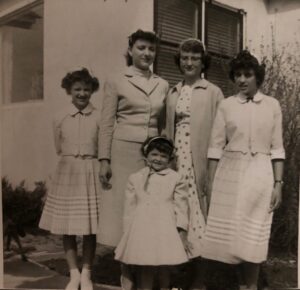 I’ve been searching since mid-February for a powder blue necklace to wear with my Easter outfit. I have looked in big anchor stores, small boutiques, and garage sales. I found it today and bought it on the spot. I knew it was perfect; it was handmade by a local artist, looked nothing like what I had pictured, and was not blue.
I’ve been searching since mid-February for a powder blue necklace to wear with my Easter outfit. I have looked in big anchor stores, small boutiques, and garage sales. I found it today and bought it on the spot. I knew it was perfect; it was handmade by a local artist, looked nothing like what I had pictured, and was not blue.
Could you not ask me to explain my impulse? I liked it, wanted it, and justified the purchase by saying it would be perfect for Easter Sunday. It is yellow, pink, mint green, turquoise, and silver, and it’s a little blingy.
My Dad used to say that my mother, my sisters, and I would “put on the dog” when we went to Easter services. I’m sure we did make a colorful procession. My mother sewed all of our clothes–always. We didn’t have much money, but we had ruffles and layers of lace with matching jackets. We each had new Easter shoes, either white or black patent leather.
I’ve always liked clothes and have way too many. Some are in step with the times, and some are a little funky, but when I dress for Easter Sunday, what I wear makes the day, from sunrise to dusk, more memorable. I know that sounds shallow, but wearing jeans and tennis shoes to an outside Easter sunrise service and then changing into a brand new outfit, often donning a floppy hat, for attending Mass, go together like peanut butter and jelly. The two activate sweet memories and reinforce hope.
In pictures of Jesus after his resurrection, he also wears what seems to be brand-new clothes.
In a quick Google search, I found that in 300 A.D., Constantine declared that his court must wear the finest new clothing on Easter.
Eventually, the tradition came to mark the end of Lent.
Poor Robin’s Almanac printed a rhyme in the 15th century: “At Easter, let your clothes be new, or else be sure you will it rue.”
In the 16th century, legend had it that moths would eat old clothes, and crows would nest around homes if people did not wear new garments at Easter.
In America, Easter, as we know it, was not celebrated until after the Civil War. New, colorful clothes were considered a source of hope, and the day was called “The Sunday of Joy.” History supports my Easter habit with reverence and respect. How convenient for me.
Whatever traditions you treasure, even if it’s making deviled eggs, I hope you do them with jubilation and that they brighten your sparkle for Easter, a Christian holiday with traditions.
Until the next time: Live while you live.
Jennifer Goble, Ph.D., LPC, is the author of “My Clients…My Teachers,” and the blogger and writer of Rural Women Stories: www.ruralwomenstories.com.
Powered by WPeMatico